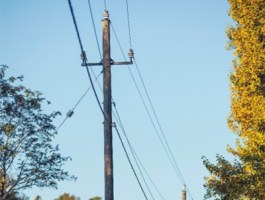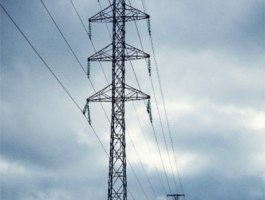
Electricity network maintenance – information on treatment of trees
We regularly inspect our electricity network. As part of network maintenance, we care for the surroundings of the electricity network by lopping, felling or shortening trees and other vegetation.
Why are trees cleared near the electricity network?
Electricity network companies must keep the electricity network in a condition required by electrical safety. That's why we regularly clear and treat trees along the electricity network and at and near primary substations. Thanks to the maintenance measures, power cuts are shorter and fewer and electricity distribution remains safe.
We perform maintenance work throughout the year. We always take into account protected or otherwise valuable natural sites as well as Natura and nature conservation areas.
The aim of maintenance clearance is to ensure electrically safe and high-quality electricity distribution
Clearance needs are highlighted during inspections of the electricity network. Inspections are performed with regular intervals both from the ground and from the air with helicopters. Clearance plans also consider future underground cabling in the area and the height of vegetation, and thus not all overhead lines are always cleared in the same area.
When clearing yard and plot areas, we will inform about the work. Information about clearance is available on our website, and we inform the parties concerned in advance. In addition, information is provided to the work environment through signs on vehicles.
We utilise both machinery and foresters in clearance
Clearing is usually carried out by both machinery and foresters. Foresters also consider felling individual trees from any special sites, such as plots, field edges and protected areas. In addition, individual trees outside the line area that pose a clear risk to the electricity network, such as damaged trees leaning towards the line, can be cleared.
Along the electricity network, vegetation is treated below the line by undergrowth clearance, lopping the edges of the line corridor, or by helicopter. In undergrowth clearance, vegetation under the line is removed and, at the same time, trees that reach the line corridor are lopped from the ground. Helicopters are used especially in lopping tall trees.
Landowners will always be notified of any edge zone logging outside a normal regularly maintained line corridor or, in the case of power lines, outside a line clearing, and the extent of the logging will be agreed separately.
Along power lines, trees may not exceed 10 metres in height in front of the border zone and 20 metres behind it. Trees taller than these are sawed or lopped as part of border zone logging.

Treatment of trees near the electricity network
We regularly clear, lop and cut down trees from line corridors of the medium voltage network and line clearings of the 110 kV high voltage network, as well as in the vicinity of the low voltage network. Regarding the possible felling of trees planted in a yard area, we will contact the owner of the property. If you want to cut down a tree near the electricity network yourself, see our guidelines on cutting down trees and the indicative dimensions of the clearance area of the electricity network, i.e. the line corridor.
Low voltage network (0.4 kV): Trees are lopped around conductors of the low voltage network every few years. Branches are removed from around the line and, if necessary, individual trees are also removed from underneath the line so that branches or trunks cannot damage the line.
Medium voltage network (20 kV): The width of a line corridor is typically 10 metres, and the trees and vegetation growing on it is cleared. The outermost trees of the line corridor are lopped every few years.
High voltage network (110 kV): The width of a line clearing is typically 26–42 metres. Trees and surroundings are cleared every few years. The treatment of any border zone outside a line clearing will be agreed separately with the landowner.
Low voltage network, medium voltage network and high voltage network



Q&A
How often do you clear the electricity network?
The typical clearing cycle for trees growing along the electricity network is six years, but there is some variation due to the length of the growing season and the growing conditions under the line, depending on the location of the network.
Can I remove trees myself?
You are not allowed to remove trees yourself. Removing trees near the electricity network is always the responsibility of professionals due to the dangerous nature of the work. Our authorised electrical professionals are allowed to work near the electricity network, and they include foresters and our helicopter partners.
For safety reasons, we cannot accept help from others for felling trees, for example in storms, even if the situation looks worrying.
How can I report a need for maintenance clearing along the electricity network?
We take into account customers' reports on clearance needs along the electricity network as part of the maintenance of future seasons.
You can report maintenance needs to our customer service for example using the chat feature.
How can I report a tree fallen on a line?
If you see that the electricity network has been damaged, for example by a tree on a line, the quickest way to report it to us is through our self-service channel Caruna+ or the chat service on the outage map.
What does tree-felling assistance mean?
You can ask us for advice on felling trees near overhead lines, we will be happy to help! If you want to cut down trees on your property in the vicinity of overhead lines, contact a local forester first.
Do I need to prepare for the clearance somehow?
No. Information on clearance is generally available on the website, and in courtyards, plots and residential areas, information on clearance is provided in advance, for example by text message. In the message, we provide the contact details and the estimated time of the clearance. Please check in Caruna+ that we have your correct contact details so that the message is sent to the correct address.
If there are production animals on a farm, they should be kept indoors, especially if lopping is carried out by helicopter. Therefore, residents in the area will be informed separately about helicopter sawing.
What happens to cut trees?
The branches, twigs and other debris from clearing are the property of the landowner. In courtyards and public areas, clearance debris is collected in neat piles. In other areas, they are left on the ground for the landowner's use and so that they are not on roads, paths, fields, ditches or their banks, or hanging on fences or trees.
The treatment of any border zone of the high voltage network outside a line clearing will be agreed separately with the landowner.
Can I visit the maintenance area?
We do not recommend a visit, as there may be forest machinery moving in the area. If you absolutely must visit the area, please inform the contact person indicated on the site sign in advance.
Where can I give feedback on clearance?
You can give feedback to our customer service for example using the chat feature.
Can I ask the clearance workers to cut down trees on my plot at the same time?
Our clearance work focuses on the treatment of trees/vegetation along the electricity network only. If you want to cut down trees on your plot, please contact a logging service provider.
Will there be a forest machine on my plot?
We take good care of plot areas, so forest machines are only used in areas where they are suitable. These are usually forested areas along the lines outside populated areas.
Where should I report a tree fallen on a telecom cable?
Telecom cables are subject to open tendering, which means that any operator can own a telecom line.
- You can identify a telecom cable by the fact that it is single-wired and thinner than the electrical cable coming from a pole.
- A streetlight cable can be identified by the fact that the pole has a lamp, and the cable looks a lot like a curled medium-voltage cable.